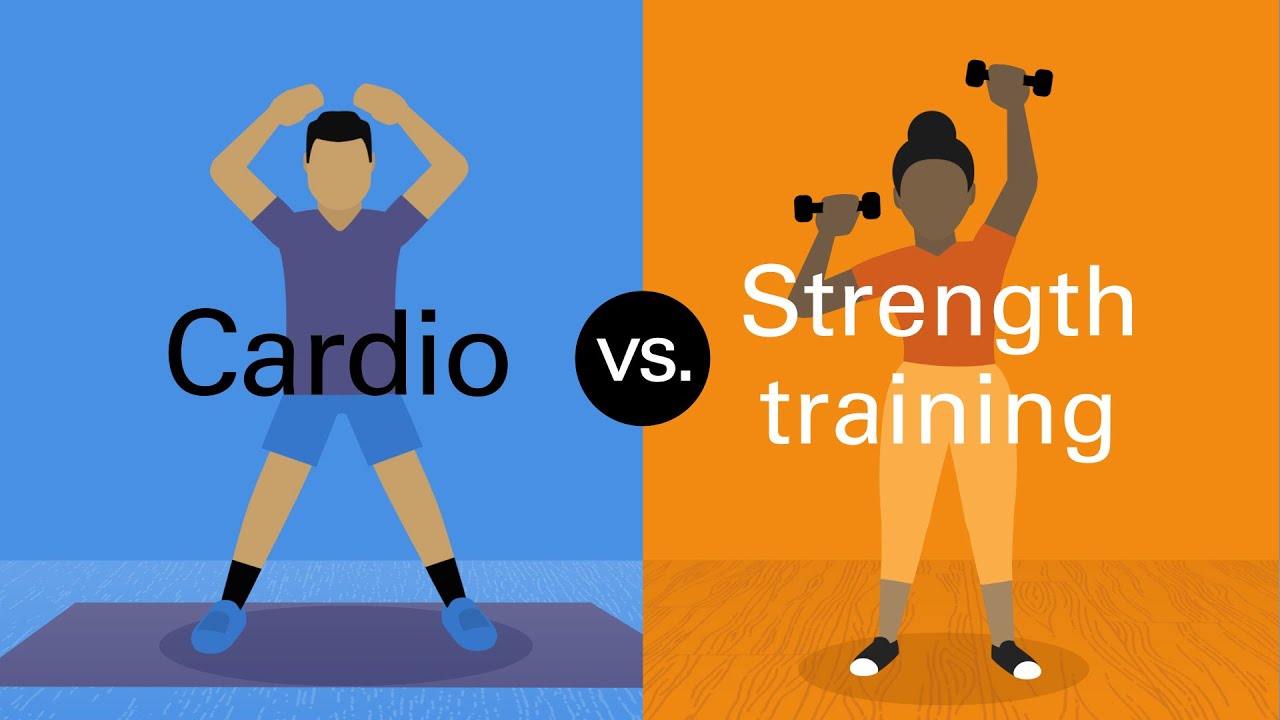Choosing between strength training and cardio often feels like picking sides in a fitness rivalry. But the smarter question is not which is better, but which is better for your goals, health, and life stage — and how can you use both to get the most benefit? This long-form guide walks you through the science, practical advice, and action-ready plans so you can design a routine that’s evidence-based, sustainable, and matched to what matters most to you.
Quick snapshot — the short answer
- Cardio (aerobic exercise): Best for improving cardiorespiratory fitness, reducing cardiovascular disease risk, and burning calories during the session. It’s essential for heart and lung health. JAMA Network+1
- Strength training (resistance/weight training): Best for building and preserving muscle mass, improving bone density, raising resting metabolic rate, and improving functional independence as you age. PMC+1
- Best option for most people: A combination of both — mixed programs deliver broader benefits (cardiovascular, metabolic, musculoskeletal, mental) than either alone. JAMA Network+1
Why this matters: health outcomes that depend on exercise type
Below are the major, research-backed health areas where cardio and strength differ — and where they overlap.
1. Heart health and mortality
Aerobic/cardio exercise directly improves cardiorespiratory fitness (VO₂max), which strongly predicts long-term mortality risk. Higher fitness levels are associated with lower all-cause death rates. JAMA Network+1
Resistance training also reduces mortality risk: cohort and systematic-review data show regular strength training is linked to lower all-cause and cardiovascular mortality, especially when combined with aerobic activity. AJP Mon Online+1
2. Muscle, mobility, and aging
Loss of muscle (sarcopenia) and bone density are major drivers of frailty and falls. Resistance training is the primary stimulus to increase muscle mass and bone mineral density — critical as you age. Meta-analyses and trials report significant BMD improvements and better functional outcomes with targeted resistance programs. PubMed+1
3. Metabolic health, insulin sensitivity, and weight management
- Cardio efficiently burns calories and improves insulin sensitivity.
- Strength training increases fat-free mass (muscle), which raises resting metabolic rate (RMR) and helps preserve weight loss. Studies show resistance training can increase RMR and improve metabolic markers over months. Physiology Journals+1
Combined programs often produce the best improvements in glycemic control and body composition for populations such as people with type 2 diabetes. PMC+1
4. Mental health and cognition
Aerobic exercise has a strong evidence base for reducing anxiety and depression symptoms and supporting cognitive health. Resistance training is also linked to better mood and cognitive function, and combining the two amplifies benefits. ScienceDirect
Table — Quick comparison: Strength vs Cardio (evidence-based)
| Outcome / Benefit | Cardio (Aerobic) | Strength (Resistance) | Notes & Evidence |
|---|---|---|---|
| Cardiovascular fitness | Excellent | Moderate | Cardio best improves VO₂max and heart endurance. JAMA Network |
| Mortality reduction | Strong | Strong (especially with combo) | Both reduce mortality; combined yields largest benefit. AJP Mon Online+1 |
| Muscle mass & strength | Low | Excellent | Resistance training builds and preserves muscle. PMC |
| Bone density | Low | Excellent | Resistance training stimulates BMD improvements in older adults. PubMed |
| Resting metabolic rate | Modest | Increases via muscle gain | RT can raise RMR over months by increasing fat-free mass. Nature |
| Weight (fat) loss | Effective (calorie burn) | Preserves lean mass | Cardio burns more session calories; RT preserves muscle during dieting. PubMed |
| Mental health & cognition | Strong | Moderate–Strong | Both help; combination gives broader cognitive benefits. ScienceDirect |
| Practicality/time-efficiency | Moderate | Moderate (short sessions effective) | High-intensity bursts of cardio can be time-efficient. Verywell Health |
Listicle — 10 evidence-backed benefits of including both cardio and strength in your plan
- Lower all-cause mortality — combined activity shows larger risk reductions than either alone. JAMA Network
- Stronger heart and lungs — cardio improves VO₂max and heart health. JAMA Network
- Better muscle and bone health — RT prevents sarcopenia and osteoporosis. PubMed+1
- Improved blood sugar control — combo programs help people with T2DM. PMC
- Higher functional independence with aging — strength keeps you able to climb stairs, carry groceries, and avoid falls. PMC
- Improved mental health — both reduce anxiety/depression symptoms and support cognition. ScienceDirect
- More effective weight management — cardio burns calories; RT protects muscle during weight loss. PubMed
- Faster everyday recovery and resilience — fitness improves how your body handles stress and illness. JAMA Network
- Time-efficient options exist — short bouts of vigorous activity can benefit heart health when time is limited. The Guardian
- Flexibility to match goals — tailor the mix depending on sport, body composition, or health needs. (Guidelines support both.) www.heart.org
How much of each should you do? (Guidelines + science)
Authoritative bodies recommend blending both:
- American Heart Association (AHA): At least 150 minutes of moderate-intensity aerobic activity (or 75 minutes of vigorous) per week plus muscle-strengthening activities on 2 or more days a week. These form the baseline for cardiovascular and musculoskeletal health. www.heart.org
- Research on mortality and activity types: Cohort data show that meeting both aerobic and muscle-strengthening recommendations leads to the best reductions in mortality; some benefit is seen even at lower doses. JAMA Network+1
Practical plan (evidence-based starting point):
- Beginner: 2–3 cardio sessions of 20–30 min + 2 full-body strength sessions/week (20–40 min).
- Intermediate: 3–4 cardio sessions (including 1 interval or hill session) + 3 strength sessions targeting compound lifts.
- Busy schedule: 15–20 min HIIT or vigorous activity 3×/week + 2 short strength sessions (20–25 min). Short but intense spurts can still benefit heart health. Verywell Health
Sample 8-week plan (balanced, scalable)
Week structure (3 strength + 3 cardio, 1 active recovery)
- Monday — Strength (Full Body): Squats, push movements, pull movements, core (3 sets × 8–12 reps).
- Tuesday — Cardio (Moderate): 30–40 min brisk walk or cycling.
- Wednesday — Strength (Lower Focus): Deadlifts/hip hinge, lunges, calf raises, mobility.
- Thursday — Cardio (Intervals): 20 min HIIT (e.g., 30s sprint / 90s walk × 8).
- Friday — Strength (Upper Focus): Bench/rows, overhead press, lat work, core.
- Saturday — Cardio (Long + Easy): 45–60 min low-intensity endurance or group sport.
- Sunday — Recovery: Mobility, stretching, short walk.
Adjust volumes progressively and use a training log. This mixed plan aligns with studies showing combined training improves many outcomes (metabolic, functional, and mortality). ScienceDirect+1
Practical tips and evidence-backed strategies
Tip 1 — Prioritize form and progressive overload in strength training
Progressive overload (gradually increasing resistance, volume, or intensity) is the mechanism that drives muscle and bone adaptations. Start light, learn technique, then add weight or sets. This is how studies see improvements in BMD and strength. PubMed
Tip 2 — Don’t be afraid of lifting heavy (relative to you)
Controlled heavy resistance (appropriate to your level) is safe and effective for increasing muscle and bone strength in older adults, producing clinically meaningful benefits. ScienceDirect+1
Tip 3 — Use cardio for heart health and calorie burn — but mix intensities
Steady-state aerobic exercise builds endurance; interval work can produce similar cardiovascular benefits faster and may fit busy schedules. Recent observational evidence even suggests very short bursts of vigorous activity can be beneficial. JAMA Network+1
Tip 4 — Combine for metabolic wins
If you have metabolic concerns (prediabetes, T2DM, central adiposity), randomized trials and meta-analyses indicate combined aerobic + resistance programs outperform single-modality programs for glycemic control and body composition. PMC+1
Tip 5 — Rest, recovery, and nutrition matter
Muscle growth and cardiovascular adaptation happen between sessions. Eat adequate protein (often 1.2–1.6 g/kg for active adults, adjusted to needs), sleep, and periodize training to avoid overtraining. Resistance training helps preserve muscle during calorie deficits. Nature+1
Scientific research highlights (universities & big studies)
- Cardiorespiratory fitness and mortality: A large study published in JAMA Network Open found that higher cardiorespiratory fitness was strongly associated with lower long-term mortality, highlighting the importance of aerobic fitness for lifespan. JAMA Network
- Resistance training & bone/muscle health: Reviews and trials from multiple research groups show resistance exercise improves bone mineral density and muscle mass, particularly important in older adults to prevent fractures and frailty. Meta-analyses published in Clinical Interventions in Aging and Journal of Bone and Mineral Research support this. PMC+1
- Mortality & combined training: Recent cohort analyses indicate balanced participation in moderate-vigorous aerobic activity and muscle-strengthening activities is associated with optimal reductions in all-cause and cause-specific mortality. (Large population cohorts and systematic reviews back this.) JAMA Network+1
- People with metabolic disease: Several randomized controlled trials and meta-analyses indicate that combining aerobic and resistance training provides superior improvements in glycemic control and body composition for people with type 2 diabetes. PMC+1
Common myths — busted
- Myth: “Lifting weights will make women bulky.”
Truth: For most women, resistance training increases toning and strength; hormonal differences make large muscle bulk difficult without specific, high-volume training and nutrition strategies. - Myth: “Cardio alone is enough for health.”
Truth: Cardio is essential, but without strength work you risk muscle and bone loss with age — both affect independence and long-term health. PubMed - Myth: “You have to spend hours in the gym.”
Truth: Short, high-quality sessions (including HIIT and focused strength sessions) can deliver measurable health benefits when done consistently. The Guardian
FAQs (Frequently Asked Questions)
Q: If I only have 3 workouts a week, should I do cardio or strength?
A: Do both — try 2 full-body strength sessions (30–40 minutes) plus 1 session of cardio (30–40 minutes). This covers both muscle maintenance and heart health. If pressed for time, make cardio interval-based and strength circuit-style. www.heart.org
Q: Which burns more fat — cardio or weights?
A: Cardio burns more calories during a session; resistance training builds/maintains muscle, helping long-term fat management. The best approach for fat loss is a combined program plus nutrition. PubMed+1
Q: Can strength training help my cholesterol or blood pressure?
A: Yes. Resistance training is beneficial for cardiovascular health and can help reduce blood pressure and improve lipid profiles, especially when paired with aerobic exercise and lifestyle changes. AHA Journals
Q: Is high-intensity interval training (HIIT) better than steady-state cardio?
A: Both are effective. HIIT can provide similar cardiovascular and metabolic benefits in less time, but steady-state cardio is easier for beginners and lower risk for some people. Choose what you can sustain consistently. Verywell Health
Q: At what age should I start lifting weights?
A: As soon as you can learn safe technique — even teens and young adults benefit. For older adults, starting resistance training yields large functional gains and reduces frailty risk. Supervision or coaching at first is wise. PMC
Q: How soon will I see benefits?
A: Cardio improvements (endurance, mood) can be noticed within 2–6 weeks. Strength gains (neuromuscular) often appear in 4–8 weeks; visible muscle change and bone adaptations take longer (months). Consistency is key. Nature
Actionable checklist — start this week
- Schedule 2 strength sessions (30–40 min) on non-consecutive days. Focus on compound moves (squat, hinge, press, row).
- Schedule 2–3 cardio sessions (20–40 min): include one interval session or a brisk walk/hike.
- Log sessions and aim for progressive increase: add 2–5% load or 1–2 reps per week for strength.
- Prioritize protein intake post-workout and ensure 7–9 hours of sleep.
- If you have chronic disease or are new to exercise, check with a healthcare provider and consider a trainer for initial technique coaching. www.heart.org+1



